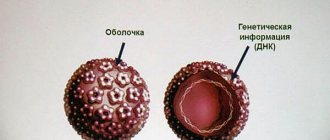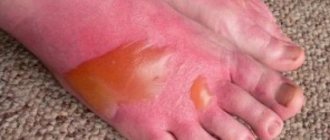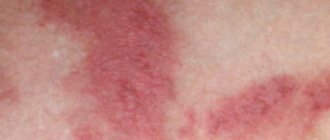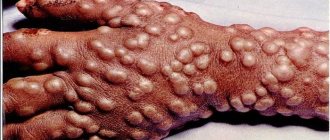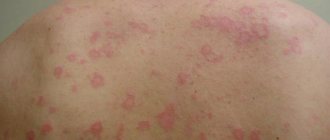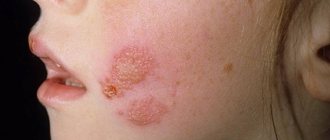Last Updated on 06/23/2017 by Perelomanet
Radiation burns (radiation) are damage to the skin by light or ion irradiation, reminiscent in structure of burns received from the sun. Such injuries can be caused by radiation treatments, nuclear accidents, X-ray diagnostics and radioactive fallout. A radiation burn differs from a sunburn, first of all, in its delayed manifestation. This means that a person will not be able to immediately detect the consequences of a procedure or incident.
Peculiarities
The most important distinguishing feature of radiation damage from thermal damage is the time it takes for symptoms to appear (that is, some time passes after irradiation and only then redness or swelling on the skin is visible). Trauma manifests itself in several places at the same time. People with highly sensitive skin are more at risk of injury (they tend to burn quickly in the sun in the summer). In addition, procedures involving radiation are difficult to tolerate for insulin-dependent people and patients with weak immune systems.
Dangerous complications
Deep radioactive burns often cause complications. They are divided into 2 groups:
- Local – pathological changes in the affected areas. Non-healing ulcers, fistulas, and abscesses appear on the skin.
- General – dysfunction of vital systems. Changes occur in the functioning of the hematopoietic, cardiovascular, nervous, immune and other systems.
The mildest complications include radiation hangover, which is manifested by loss of appetite, decreased blood pressure, and emotional lability. Under the influence of radiation, neurological disorders, insomnia, and baldness occur.
The most dangerous complications occur with radiation sickness. Its symptoms depend on the total dose of radiation absorbed by the skin. Late consequences include:
- aplastic anemia - inhibition of the functions of the hematopoietic system: the synthesis of red blood cells, leukocytes, platelets by the bone marrow stops;
- Radiation cataract – clouding of the lens caused by radiation;
- pneumosclerosis - the formation of connective tissue adhesions in the lung tissue;
- radiation proctitis – inflammation of the rectum provoked by high doses of radiation;
- leukemia is a malignant blood pathology in which the bone marrow begins to produce immature leukocyte cells.
Some delayed complications are fatal. Radiation doses of more than 1 Gy (100 rad) are often accompanied by pathologies of the bone marrow and gastrointestinal tract.
Classification
A radiation burn can differ in its characteristics, some of them are strongly expressed, others are somewhat weaker. Stages of manifestation:
- The first (early) - manifests itself in severe redness of the skin, appears after several hours or days from the moment of injury.
- Second (secretive) – the duration of the stage reaches several weeks. The sooner obvious signs appear, the more severe the degree of burn.
- Third (pronounced inflammation) - in this case, ulcerative open wounds, watery blisters and severe swelling appear on the damaged area. Inflammatory processes can last several months, depending on the individual cellular ability to heal.
- The fourth stage is recovery.
Severity is divided into four categories:
- Mild - occurs with exposure to no more than 1200 rads, symptoms are detected after a few weeks. Even patients with weak immune functions recover quickly and easily survive the injury.
- Moderate – occurs at a dose of 2000 rads, swelling and redness occur in the affected area. It occurs secretly, it is possible to identify this stage only after two weeks, the rehabilitation period lasts about a month.
- Severe - open wounds and ulcerative cavities form, the tissue dies and is no longer restored.
- Fatal - complete damage to the skin, muscles and even bones occurs. Irradiation can leave tissue only with charred particles.
Depending on the location area:
- skin;
- mucous membranes;
- vital organs.
Degrees
Radiation skin lesions come in four degrees of severity:
- 1st degree. Burns appear approximately two weeks after a small dose of radiation and are the least dangerous. Damage from this degree is insignificant and is expressed in the form of slight redness, the effect of hair removal and exfoliation of the upper layers of the skin.
- 2nd degree. Symptoms of such a burn appear in less than 2 weeks after exposure to moderate doses of radiation. This degree may be characterized by the appearance of blisters, extensive redness, secondary erythema, and in some cases accompanied by pain.
- 3rd degree. The onset of symptoms occurs from 3 to 6 days and is accompanied by the appearance of severely healing ulcers, erosions, swelling of the skin and blisters, followed by necrosis.
- 4th degree. This type of radiation burn is considered the most severe and dangerous. They appear almost immediately after a negative impact on the skin and is expressed by damage to the upper layer of the skin, muscles, the occurrence of ulcers and necrotic processes.
From the second to the fourth degree, in addition to the above symptoms, fever, regional lymphadenitis and leukocytosis may also appear.
Causes
Radiation burns are more common in people with weakened immune systems or sensitive skin. The radiation type of radiation, in this case, provokes special susceptibility and subsequent injuries. Among other things, active isotopes or elements used in the operation of nuclear power plants (rare) can cause such damage.
Trauma of this type is also typical for patients undergoing radiation therapy (prescribed for malignant neoplasms and other diseases). Depending on the degree of exposure and the individual characteristics of the body, various symptoms may appear.
Symptoms and signs
The main symptoms of an ultraviolet or radiation burn depend on its severity. So, it is characterized by the following signs:
- Redness;
- The appearance of blisters;
- Increased body temperature;
- Local soreness, itching.
After 5–14 days, the local reaction will begin to subside. First, the formation of scales on the epithelium and their gradual exfoliation will be observed. In place of the blisters, minor scars may form, which are then replaced by normal skin of a lighter tone.
Note! In the absence of infection, radiation burns go away completely without a trace, unlike thermal burns, the third and fourth degrees of which, as a rule, lead to the formation of rough scars.
Symptoms
Minor burns (first degree) are accompanied by itching and redness, sometimes peeling, swelling and slight pigmentation are observed. In the second degree, blisters, headache, nausea and vomiting, and acute pain in the damaged area appear.
It is strictly forbidden to open the blisters yourself, as this can cause increased pain symptoms and pathology in the future.
More serious categories of burns are characterized by bloody blisters, ulcerations, necrosis, fever, and leukocytosis. Over time, scar tissue forms, after which it can fester and, in the absence of adequate treatment, turn into cancer. There is a risk of developing thrombosis of the venous system.
Prevention
To avoid ultraviolet burns you must:
- The first sessions of sun exposure should not exceed 10 minutes at a time and 30 minutes throughout the day;
- When tanning, it is necessary to use special creams that reduce the intensity of exposure to ultraviolet radiation;
- If the skin already has any manifestations of damage, exposure to the sun should be stopped for 1 - 2 days.
In order to prevent radiation burns, it is necessary to use personal protective equipment and minimize the time spent working with a source of ionizing radiation.
When conducting radiation diagnostics or therapy, you must strictly adhere to the rules of work and behavior.
A burn is tissue damage that occurs under the influence of high temperature (thermal burn), acids and alkalis (chemical burn), electric current (electrical burn) or ionizing radiation (radiation burn). Each type of burn has its own rules for first aid.
Thermal burn.
Thermal burns can be caused by the rays of the sun, hot water, water vapor (not to be confused with chemical vapors), open flames, hot oil, molten metal, hot food, hot heating devices, electric and gas stoves, soldering equipment, hot dishes and much more.
Procedure (pre-medical):
- Stop exposure to the damaging factor (if the victim is burning, extinguish the flame by throwing on a coat, blanket, wet cloth, pour water on or dip the victim in water).
- Remove the burned part of the body from clothing, cutting it off around the burned area. Leave the stuck fabric in place.
- Do not
touch the burned surface with your hands,
do not
open blisters,
do not
lubricate with ointment, grease, alcohol (alcohol can
only
on the surface of a sunburn) or other substances. - Cool small burn surfaces with cold water, ice, or snow.
- Apply a clean sterile bandage (in the field, as a rule, sterile tissue cannot be found, so a clean handkerchief, disposable napkins and, in extreme cases, cellophane will do). For extensive burns that occupy a large surface of the body, the victim is wrapped in a clean sheet.
- In case of eye burns, apply a sterile bandage to the eyes.
- Treat the surface around the burn (without touching the burn site itself) with alcohol or vodka in order to fix the pathogenic microflora in place.
- Provide plenty of fluids
Chemical burn.
Chemical burns can be caused by chemical reagents of industrial acids and alkalis; fumes of acids and other chemicals; smoke generated by the combustion of plastic (it contains phosgene and gaseous hydrocyanic acid, such smoke is poisonous and causes chemical burns), food acids (acetic essence, vinegar).
Procedure (pre-medical):
- Stop exposure to the damaging factor.
- If clothing becomes saturated with a chemically active substance, you should try to quickly remove it.
- In addition to burns with quicklime, the affected surface is washed with plenty of tap water as quickly as possible to reduce the concentration of the substance.
- Neutralization of a surface doused with acid with a 2% solution of baking soda (or any soda solution that you have time to prepare).
- Neutralization of a surface doused with alkali with a 2% solution of acetic or citric acid (or any solution of acetic or citric acid that you have time to prepare).
- If the larynx or esophagus is burned with acid, rinse the oral cavity and drink (except for cases of acid getting into the stomach, in which case you cannot drink a neutralizing solution
, since as a result of the neutralizing reaction carbon dioxide will be released and can swell the stomach) 2% sodium bicarbonate solution (food grade) soda), burnt magnesia or almagel. - If the larynx or esophagus is burned with alkali,
rinse the oral cavity and drink (except for cases of alkali getting into the stomach, in which case
you cannot drink a neutralizing solution
, since as a result of the neutralizing reaction carbon dioxide will be released and can swell the stomach) 1% acetic acid solution. - take antispasmodics to relieve spasm of the esophagus.
Electrical burn.
An electrical burn is caused by an electric shock. First aid consists of stopping the impact of the damaging factor on the victim (de-energizing) and then, if the person is fully conscious, measures are taken according to the scheme of assistance for thermal burns (see above).
Treatment
It is easier to understand how the treatment of radiation burns occurs if we conditionally divide it into several groups.
Therapeutic method
Minor injuries do not require surgical intervention and can heal on their own; with qualified assistance, the healing process will occur much faster. The patient is advised to eat properly (less spicy, fatty and sweet), and also drink plenty of fluids. An ointment based on natural ingredients (sea buckthorn, aloe) should be applied to the skin, but only as prescribed by a doctor. Unpleasant symptoms are eliminated with the help of sprays and painkillers.
Possible complications
- radiation reaction: dysfunction of the nervous, cardiovascular, endocrine systems;
- atrophic, hypertrophic, chronic radiation dermatitis;
- functional disorders of the lungs and bronchi;
- sclerotic processes in the myocardium, lungs, liver, kidneys and other organs;
- radiation pericarditis (heart damage);
- damage to the walls, intestinal mucous membranes, erosion;
- functional kidney failure;
- radiation cystitis;
- radiation lymphostasis;
- radiation tumors.
Medicinal method
In addition to dressings with antiseptic solutions, antibiotics and sulfonamide are prescribed (provided there is normal blood circulation) if the affected area is infected. Swelling is relieved by taking antihistamines (local and general). Additionally, the patient undergoes a course of vitamin therapy. If therapeutic and medicinal treatment does not bring the expected result, surgical intervention is prescribed.
Surgical care for stage 3 and 4 radiation burns - indications and types of operations
Surgical manipulations for this pathological condition can be prescribed for deep burns that affect the muscle layers.
If the wound is severely infected, antibacterial treatment is first carried out, and only then surgery is started.
The wound area is thoroughly cleaned of dead tissue. This all happens under general anesthesia. This type of surgery is called necrectomy.
Subsequently, the operator transplants a graft taken from another area of the patient's skin.
Operation
The patient is subjected to general anesthesia (the person is unconscious) and areas of scar tissue and foci of necrosis are removed. Surgical intervention is planned in advance. Before treating a patient, sensitivity to medications is clarified, tests are performed, and a general clinical picture is collected.
Additionally
Try to use the services of private clinics (if possible) when performing procedures with ionizing radiation. Experienced doctors must correctly calculate the rate and dosage of rays. The areas affected by the device must be lubricated with special products (just not before the procedure).
Complications are most often inherent in the last stages; pathologies are mainly associated with wound infection and heavy bleeding. Radiation burns of the first and second stages have a positive prognosis and are often completely cured
First aid
Radiation injuries are dangerous due to delayed complications. Their severity depends on literacy and speed of provision of first aid. If redness occurs on the body 15-20 minutes after irradiation, you need to call a doctor at home. Such early local manifestations indicate absorption of a high dose of ionizing radiation by the body.
As first aid, apply a sterile or antiseptic bandage. You can also wash the exposed skin with plain or soapy water. Then you should go to the doctor.
First aid for radiation burns:
- cloth wipes soaked in a solution of hydrogen peroxide or chlorhexidine are applied to the affected areas;
- within 10-12 hours after radiation injury, the affected areas are washed with a soap solution;
- for complaints of pain, non-narcotic analgesics are given - Naproxen, Ibuklin.
After emergency assistance is provided, a doctor is called or sent to the hospital. To prevent purulent complications, the victim is prescribed antibiotics and drugs to cleanse the blood of radionuclides.
